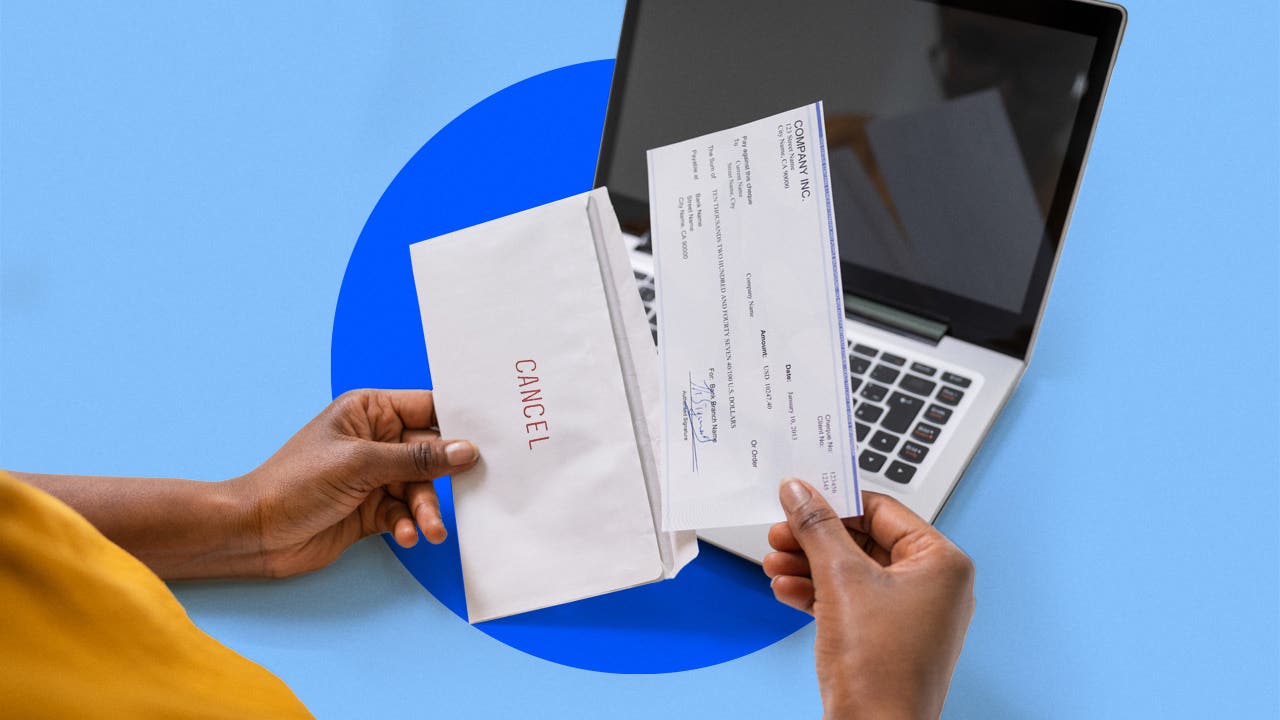How to cancel a check: 4 important steps

The Bankrate promise
At Bankrate we strive to help you make smarter financial decisions. While we adhere to strict , this post may contain references to products from our partners. Here's an explanation for .
Our writers and editors used an in-house natural language generation platform to assist with portions of this article, allowing them to focus on adding information that is uniquely helpful. The article was reviewed, fact-checked and edited by our editorial staff prior to publication.
Key takeaways
- Act quickly when canceling a check to ensure it has not already been processed.
- Canceling a check may come with a fee, but it can save you from potential fraud or incorrect payments.
- You can cancel a check online, over the phone or in person at your bank.
- It’s important to understand how long a cancellation request will be honored and to monitor your account for successful processing.
If you need to cancel a check, you can ask your bank to cancel it and avoid having the funds withdrawn from your bank account. Follow these steps to stop that check in its tracks before it clears.
1. Find out if the payment has already been processed
Before you start the process of canceling a check, review your checking account activity to verify that the check has not yet cleared. The bank will not be able to stop the payment if the check has been cashed or is being processed.
If you don’t see the amount in your transaction history, it’s important to act fast so that the check isn’t deposited before you have time to intervene.
Some banks may allow you to freeze your account through their mobile apps or online banking sites. This is a temporary step you can take to stop payments from going through until the bank cancels the check. Note, though, that a freeze will stop other payments from going through, too.
2. Have your account number and check number ready
Make sure you have the key information your bank will need to process your request: your account number and the check number. You may also need to include the payment amount and the recipient’s name.
The bank might request information on why you are canceling the check. Was it made out for the wrong amount or to the wrong payee? Are you disputing the transaction? Or was the check stolen?
If you’re worried about a lost checkbook, the bank may need to do more than simply stop one payment. In that case, the bank may ask you to close your account and open a new one.
3. Contact your bank – and get ready to pay
Once you have all the details, it’s time to contact your bank or credit union. Even though you are looking to cancel a check, you might not see that exact wording on your financial institution’s website. Instead, you might see “stop payment.” It accomplishes the same objective: not allowing those funds to leave your account.
It’s best to cancel a check online if your bank offers the option, for two reasons: it puts the request in writing and it might be a bit cheaper.
For example, Chase customers can save $5 by using an online or automated system to cancel a check instead of calling to request a stop payment through a banker. If you cannot access your bank’s online services, it’s best to call the customer service number on the back of your debit card.
If you have an account at a traditional bank, you’ll probably pay a fee in exchange for not paying the amount on the check. You may be exempt from the charge if you have a higher-tier account, though. Check out the typical costs for canceling a check at some of the most-recognized names in banking.
| Financial institution | Fee for canceling a check |
|---|---|
| Bank of America | $30 Waived for: Bank of America Advantage Relationship Banking, Bank of America Advantage with Tiered Interest Checking and Bank of America Advantage Regular Checking accounts plus Preferred Rewards customers |
| Chase Bank | $30 ($25 if the request is made via chase.com, the Chase mobile app or the bank’s automated phone system) |
| Citibank | $30 Waived for: Customers with Citi Priority and Citigold account packages |
| TD Bank | $30 Waived for: Beyond Checking, Beyond Savings, Signature Savings, Private Tiered Checking and Private Tiered Savings account holders |
| PNC Bank | $33 Waived for: Performance Select customers |
| Fifth Third Bank | $33 Waived for: Preferred Banking customers |
4. Understand how long your request will be honored
Stopping a payment may not mean forever. Make sure you understand how long your request will be honored.
If you requested a stop payment orally, the request may only be honored for up to 14 days. It’s a good idea to follow up in writing, in which case most stop payment policies last for six months. However, there are exceptions. And even if you canceled the check, it’s still smart to monitor your account activity to make sure the request was processed successfully.
When should you cancel a check?
There are several instances when you might want to consider canceling a check, including:
- If the check is lost or stolen: You’ll want to prevent unauthorized use and protect your funds.
- If you made a mistake: Perhaps you wrote the wrong amount or paid to the wrong recipient.
- If you’re disputing a transaction: Unhappy with a purchase or service? Canceling the check can be a way to resolve the issue.
- If you suspect fraud: If you have reason to believe someone is trying to defraud you, canceling the check can help protect your money.
–Bankrate’s Sheiresa McRae Ngo contributed to an update of this article.
Related Articles



